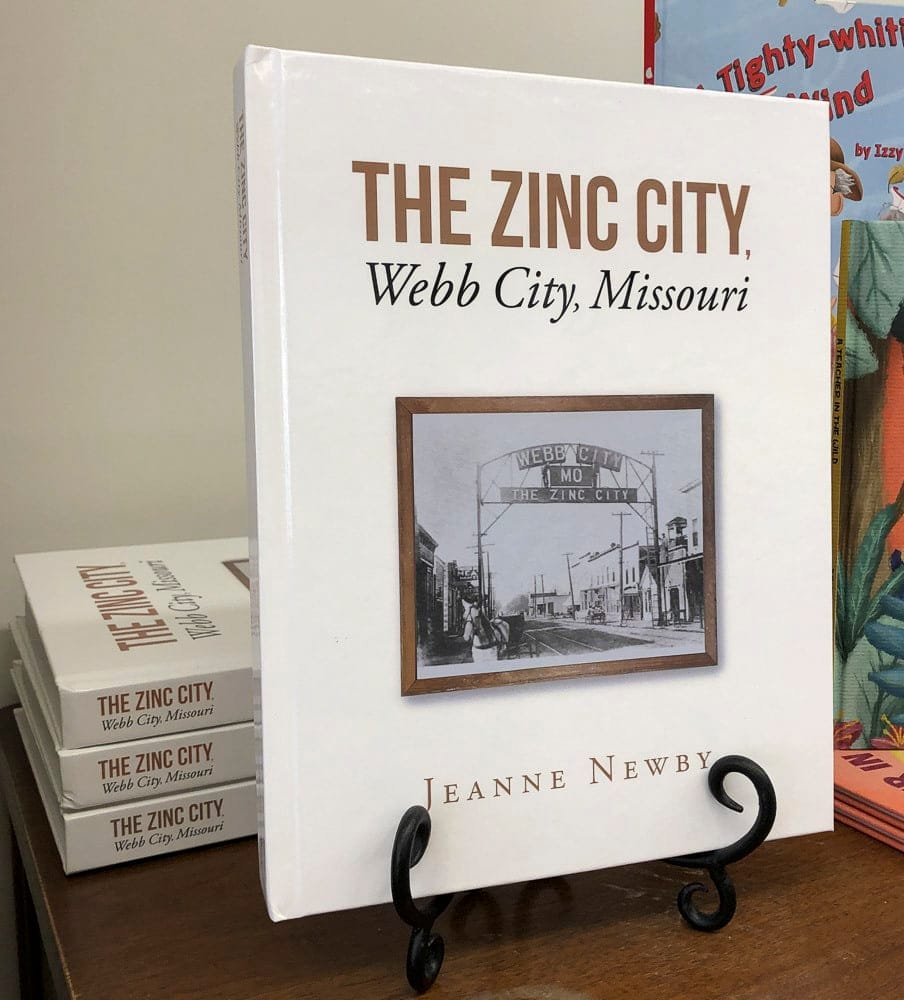During discussions of the Civil War, Webb City is often left out because Webb City wasn’t built or even thought of at the time.
The founder of Webb City, John C. Webb, was living in his log cabin, which would now be northwest corner of Broadway and Webb Street.
Webb was farming his land, but the heat of the war was around him. There were many skirmishes in and around Jasper County. Citizens were being killed in their own homes or yards by the Federals, Colonel Ritchey’s Indians, Union troops, Rebels and the state militia. Life in Jasper County was uncertain with so much killing.
Not long after the war began, Webb answered the call issued by Gov. Jackson and joined the Missouri State guards, enlisting for the suggested six months. He sent his family to Texas to be safe while he was gone. After his enlistment time was up, he joined his family in Texas until the war officially ended.
In the meantime, many of Webb’s extended family members were still in the Jasper County area. Thomas Webb and his family lived in Pilot Grove (where Mount Hope Cemetery is). In 1864, Tom and his son were captured at their home by the Federals. They were taken about a mile south and killed. Tom’s neighbor was taken to Neosho and killed by the state militia. Another neighbor was killed by the Federals. It was hard to know exactly which group was the enemy. One Jasper County man pretended to be a Rebel when he was attacked in his home. He did not take a stand for any side but lost his life because he thought the men after him were the Rebels and they were not.
John Webb’s family living at the head of Turkey Creek had a neighbor killed on their prairie by the Federals. It was stated that Jabez T.E. Hatcher lived near where Webbville would be located. He was killed by Federals. John C. Webb’s brother, William J. Webb, served under General Shelby during the war. After the war, in 1873, William came back to Jasper County, settled close to John C. Webb and opened a blacksmith business.
There were many massacres by Colonel Ritchey’s Indians around where Georgia City would later stand, but just down the road at Galesburg, the Federals were doing massacres of their own. Colonel Ritchey’s Indians moved from Georgia City to Minersville (Oronogo) and added to the number of men they killed.
Other places where action took place in Jasper County were Medoc, Sherwood, Sarcoxie, Carthage, Shirley’s Ford, White Oak, Nashville and Willow Springs.
So, even though Webb City was not a town at the time of the Civil War, the effects were felt all over this part of Jasper County. What terror the citizens of Jasper County suffered.
It was just a few years after the war, in 1873, that John C. Webb returned to his farm and uncovered lead while plowing. Sadly, he died just 10 years later , in 1883, leaving behind a growing town that carried his name.
There were many Jasper County residents who fought in the Civil War, including Joseph W. Aylor, who served with Pindall’s Battalion of Sharp Shooters, attached to General Parson’s Corps. Joseph Fountain, belonged to the Sixth Kansas Volunteer Calvary and served until the end of the war. He had lived in Jasper County since he was 13 years old. John G. Lofton served with the 32nd Illinois Infantry for three years. Lofton has shared many memories with me.
I have heard many times that the Civil War was terrible, as brothers fought against brothers, fathers and sons were on opposite sides and childhood friends were pitted against each other. But here, in a county that hadn’t taken sides, many people were killed because they were in the path of men who seemed to kill just to kill.
Saddest yet was many of the soldiers were teenagers.
I did not mention the action in Carthage or Joplin, which would have included many more sad incidents. But those men fought the battles for their beliefs and their families. However, with any war, sadness overcomes many heroic events.
We honor those from our area who took up the challenge, no matter which side they fought. They were doing what they thought was best.
Time line from the beginning of the Civil War until the day John C. Webb found that piece of lead.
1860 – Jan. 27, Preston (east of Alba), the seventh city of Jasper County was platted by Luke E. Ray and Jacob Nicholson. Dr. Patterson built the first building, a general store. The town burned during the Civil War. It was replatted Sept. 10, 1867.
1861 – John C. Webb answered the call of Gov. Jackson to voluntarily serve in the Confederate Army.
1861 – July 5 – Battle of Carthage
1861 – Aug. 23 – Skirmish at Medoc between Confederates and Union sympathizers enroute to Fort Scott to enlist in the war.
1862 – June 18, Coon Creek Engagement between Confederates and Union in northern Jasper County.
1862 – Skirmish between the Confederates and an Indian regiment started at an old mill near what would soon become Lakeside. The Indian regiment was overtaken at Shirley Ford on Spring River. Confederates had a dispute among themselves and the Indians. The regiment escaped.
1862 – Nov. 20 – A short engagement between the Confederates and Union near Carthage
1863 – Fight just south of Sherwood, which resulted in the Confederates sustaining severe loss
1863 – May 14 – Skirmish at French Point, which was located west of Oronogo, with a second skirmish on May 18. The Confederates came out ahead.
1863 – May 19- Skirmish at Sherwood (Fountain Road) which resulted in the burning of Rader home by the Federal soldiers.
1866 – Joseph W. Aylor moved to Webb City and on Jan. 21, 1866, married Miss C.M.E. Webb.
1866 – Ulysses Hendrickson moved to Jasper County, three miles west of Oronogo. He became county sheriff in 1874. In 1890, he was elected to the Senate for four years.
1867 – Dr. David Whitworth moved to Jasper County and purchased land west of the future Webb City. Served as a doctor in Webb City until 1895.
1867 – The town of Preston (east of Alba) which was first platted in 1860 and burned during the Civil War. It was replatted on Sept. 10, 1867.
1868 – Granby Mining and Smelting Co. obtained control of the mines in Oronogo. Colonel J. Morris Young, superintindent of the company, served as a legislator 1869 – 1870
1869 – Joseph Aylor and Andrew McCorkle began mining in neighboring towns. Aylor lived on the hill across from what would become Mount Hope Cemetery. The hill was referred to as Aylor Hill.
1870 – W.A. Daugherty purchased 260 acres of land just west of John C. Webb, on what is known as Colonial Road. He soon purchased 320 acres east of John Webb from James Gilbert Leroy Carter.
1870 – Andrew McCorkle purchased 80 acres just south of John C. Webb and built a 1½ story home at 106 S. Webb Street. He built a larger home in 1899 on the same spot.
1870 – Oct. 1 – John Cox leased 90 acres on Joplin Creek for Moffett and Sargeant to mine.
1871 – Granby Mining Company heard about Adolph Von Wiese, a German who had discovered a use for zinc. The company gathered up all the “Black Jack” waste that had been cast aside and sent it to Von Wiese and the value of zinc was established and became more valuable than lead.
1871 – May 7 – 26-year-old William E. Hall married 18-year-old Martha Ellen Webb, daughter of John C. Webb.
1872 – The Memphis, Carthage, and Northwestern (later the St. Louis & San Francisco) Railroad was built through Oronogo.
1873 – A bright June morning, John C. Webb was plowing his land (between what would later be Webb City and Carterville) when he uncovered a shiny rock known as lead. He did not make it known to anyone for about four months.

Jeanne’s new book, “The Zinc City, Webb City, Missouri” is now available at Webb City Chamber office and other local retailers, such as Maggie Jane’s Gifts, at 8 S. Main St.



The Webb City Sentinel isn’t a newspaper – but it used to be, serving Webb City, Missouri, in print from 1879-2020. This “newspaper” seeks to carry on that tradition as a nonprofit corporation.
© All Rights Reserved 2024
DIY website design by Bob Foos